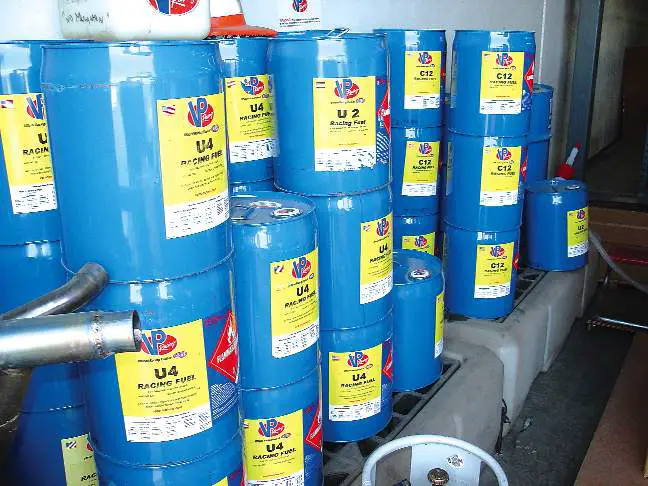BLACK & WHITE: AMA FUEL RULES: DO THEY ACTUALLY EXIST?

Nothing is more controversial or misunderstood than the AMA fuel rules. It has proven to be a sore subject with the teams, riders and fans. And making it worse has been the terrible manner in which the AMA has handed out penalties?or hasn’t handed out penalties. The first big fish caught in the AMA “Fuel Gate” was Jeff Emig. Emig’s 1996 Indianapolis Supercross fuel reportedly had too much oxygen, so he was disqualified. Then, Chad Reed, David Vuillemin and Tyson Hadsell were penalized 25 points each for having fuel that tested out of compliance on lead content at the 2004 Dallas Supercross (although they got to keep their finishing positions and purse money). A year later, in 2005, the AMA penalized James Stewart and Michael Byrne 25 points for too much lead (they, too, got to keep their finishing positions and purse money). Finally, at the 2006 San Diego Supercross, Ricky Carmichael’s fuel failed the lead test.
Was he disqualified as Jeff Emig had been? No. Was he penalized 25 points as Byrne, Stewart, Vuillemin, Reed and Hadsell had been? No. Instead, Carmichael was fined $20,000, which Suzuki paid, and Ricky got to keep his finishing position, purse money and AMA points. Oh, yeah, and the 25 points Ricky got to keep earned him the 2006 Supercross Championship, which he would have lost to James Stewart by 23 points.
All racing organizations have fuel rules, largely to keep the competition fair and the costs down. Where you stand on the fuel issue depends on whether you are Ricky Carmichael or Reed, Stewart, Vuillemin and Byrne. You be the judge.
WHITE
AMA FUEL RULES: The AMA fuel rules are fairly basic and straightforward. They regulate specific gravity (0.715 to 0.765 at 60 degrees), oxygen content (4 percent) and oxygenates (ethers and alcohols only).
PENALTIES: The 2011 AMA rule book calls for “automatic” disqualification of any rider whose fuel is found to be out of spec. Of course, no one believes that such a penalty would be levied against a factory rider?only a privateer or a French rider.
ENFORCEMENT: Fuel tests are expensive and time-consuming; the results often take two weeks to get and then are subject to appeal and retest. Thus, fuel tests are few and far between?(much like drug tests and sound tests). The AMA is afraid of the factory teams and their reaction should their riders be penalized, so rather than incur their wrath, they just don’t do fuel tests anymore.
LOGIC: The main reason for a fuel rule is to control the “haves” and protect the “have-nots.” The AMA regulates fuel to keep the factory teams from buying exotic racing fuels with price tags that are 10 times that of premium pump gas. By setting limits on oxygen, specific gravity, lead, pressure additives, oxygenates and, of course, nitro, they keep the playing field somewhat fair.
BLACK
AMA FUEL RULES: The AMA fuel rules may be basic, but they aren’t stable?and won’t be for the foreseeable future. The oxygen content has changed from 2.7 percent to 4 percent to cater to the teams, and soon the AMA and FIM plan to develop a new international standard, which will most likely make things worse. The impetus for the original unleaded fuel rules, which banned the leaded fuel that two-strokes needed, was a fairy tale desire to be politically correct and a wish to comply with FIM standards. High-end, high-profile race engines need high-end, high-quality racing fuel. Limiting the fuel or raising the price of the good stuff does not level the playing field. Instead, it punishes two-strokes more than four-strokes and produces race gas that costs $40 a gallon.
PENALTIES: There is little chance that any rider will be caught in a fuel-test controversy ever again. Why not? Because the Ricky Carmichael incident proved that fuel rules were enforced based on who you were, not on what was in your gas tank. The AMA can’t afford to be put under scrutiny on this issue.
ENFORCEMENT: If you don’t test fuel, then you don’t need enforcement.
LOGIC: What AMA professional racing needs is an “Official Fuel of AMA Pro Racing.” Guess what? Sunoco is the official fuel of AMA Pro Racing?but that only applies to road racing, not Supercross or motocross. An official fuel would mean that every rider on the track would be running the same fuel. There would be no special blends or excessive prices. Since AMA Pro Racing is not connected with AMA Supercross, the idea of an “official fuel supplier” is not likely, but it should be.




Comments are closed.